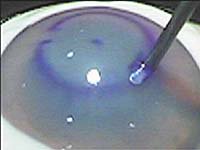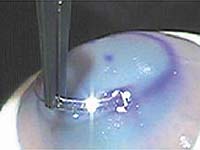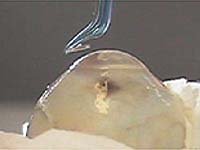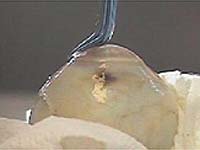New instruments make Intacs procedure easier, faster
Newly developed instruments for creating the stromal pocket, starting the tunnel and inserting the micro-inserts simplify the Intacs procedure.
BOSTON — Reducing the number of instruments improves the ease of pocket formation for the insertion of Intacs micro-thin prescription inserts (KeraVision Inc.; Fremont, Calif.) and can make the procedure as fast and easy as laser in situ keratomileusis (LASIK), according to Alan W. Brown, MD, who presented his experiences with newly developed instruments at the American Society of Cataract and Refractive Surgery meeting held here.
“Pocket formation is very important. You have to get the maximal depth. You want the same depth for both pockets so we don’t induce astigmatism, and you don’t want to disrupt the epithelium,” Dr. Brown said.
 |  |
| Two pockets are created simultaneously so that they are at the same depth. Then the surgeon can square up the pockets just by pushing the instrument forward and then backward. The dual rotary motion stabilizes the globe during pocket formation to eliminate globe rotation, without the need for a second instrument to counterbalance the globe. | |
Stromal pocket
 ---The Brown Insertion Forceps uses the same geometric arc motion of the tunnel dissector to insert the Intacs.
---The Brown Insertion Forceps uses the same geometric arc motion of the tunnel dissector to insert the Intacs.
Intacs are implanted in the periphery of the cornea where they gently reshape the anterior corneal surface, while maintaining the positive asphericity of the cornea. Intacs are designed to remain permanently within the cornea; however, they can be removed or replaced as patient’s visual needs change. The Intacs procedure calls for the creation of a stromal pocket and tunnel for the insertion of the micro-inserts. One of the more challenging aspects of the procedure requires the surgeon to create two stromal pockets of identical depth without disrupting epithelium on an eye that tends to rotate away from the instruments used to create the pockets.
“You have to provide some kind of countertraction while you’re inserting all these instruments for creating the pocket, and it’s difficult to create a pocket of identical depth, unless you are very careful, when pockets are formed sequentially,” Dr. Brown said.
Dr. Brown invented the Brown Pocket Starter (Rhein Medical Inc., Tampa, Fla.) to simplify the Intacs procedure. The Pocket Starter is an instrument in the shape of a T that is inserted into the base of the radial incision and then rotated. Two pockets are created simultaneously so that they are at the same depth. Then the surgeon can square up the pockets just by pushing the instrument forward and then backward.
“The Starter combines three steps into one by acting as a Sinskey hook, pocketing hook and Suarez spreader, reducing epithelial contact and minimizing corneal disruption. The dual rotary motion stabilizes the globe during pocket formation to eliminate globe rotation, without the need for a second instrument to counterbalance the globe,” according to John A. Bee, president of Rhein Medical Inc.
“What’s really nice about it is that the counter-traction is automatic. You don’t have this eye moving all over the surgical field. Since we only use one instrument, the epithelium is pretty much untouched and it’s a lot faster. It’s hard to avoid the epithelium if you use Sinskey or Suarez and pocketing hooks and a glide,” Dr. Brown said.
Insertion
 ---The bottom of the forceps is highly polished so that it can rest right on the eye.
---The bottom of the forceps is highly polished so that it can rest right on the eye.
Insertion of the Intacs using the KeraVision forceps can be a bit tricky, Dr. Brown said. The surgeon must tilt the forceps a little bit to get it in the incision, keep it over the pupil and use a rotary motion. During the procedure, the forceps can damage the epithelium when grabbing and releasing. The awkward wrist movement and having to go back and re-grab and push make this step in the procedure difficult, he said.
“For me, it’s just easier to use my fingers in a rotary motion,” Dr. Brown said. “I wanted to redesign the forceps because it was awkward for me to use my wrist and arm movement. With these forceps, you grab and then you have to twist your wrist and your arm and your elbow goes out. My fingers are a much better surgeon than my wrist and my elbow.”
Dr. Brown’s redesigned forceps (Brown Insertion Forceps; Rhein Medical) use the same geometric arc motion as the tunnel dissector to insert the Intacs. The bottom of the forceps is highly polished so that it can rest right on the eye. Even with it resting on the eye, the Intacs are held off the epithelium because the lower jaw is always keeping the Intacs off the epithelium and the jaw is in constant contact. The improved forceps allow the Intacs to be rotated into the tunnel by using a gentle rotary finger movement. There is a notch in the forceps that holds the Intacs securely above the epithelium to avoid contact during insertion, which reduces epithelial disruption and prevents foreign material from entering the tunnels.
“We didn’t get to where we are with LASIK overnight,” Dr. Brown said. “I think the real benefits of Intacs micro-inserts are that they are removable. And as we improve the instrumentation, I really think we’ll find that this procedure becomes as easy as LASIK, and it gives our patients another option. And if you want to be in comprehensive refractive surgery, I think you should be able to offer all the different options for people who are interested.”
 |  |
| Even with it resting on the eye, the Intacs are held off the epithelium because the lower jaw is always keeping the Intacs off the epithelium and the jaw is in constant contact. | |
For Your Information:
- Alan W. Brown, MD, can be reached at Surgical Eye Associates, 1717 Shipyard Blvd., Suite 140, Wilmington, NC 28403; (910) 796-8600; fax: (910) 796-8644. Dr. Brown has a direct financial interest in the Brown Pocket Starter and the Brown Insertion Forceps. However, he is not a paid consultant for any companies mentioned.
- John Bee can be reached at Rhein Medical Inc., 5460 Beaumont Center Blvd., Ste. 500, Tampa, FL 33634; (813) 885-5050; fax: (813) 885-9346.
- KeraVision Inc. can be reached at 48630 Milmont Drive, Fremont, CA 94538; (510) 353-3000; fax: (510) 353-3030.
